Pushing the limits as a team – safe helicopter landings on vessels
AIN-News- Date:
- Reading time:
- 6 MIN


Wind and rough seas on the oceans: the new naval multirole helicopter, the NH90 Naval Transport Helicopter (NTHNaval Transport Helicopter) Sea Lion, must be able to take off and land safely on ships even in difficult weather. To this end, experts of the Bundeswehr Technical Center for Aircraft and Aeronautical Equipment (WTDWehrtechnische Dienststelle 61) and naval aviators of Naval Air Wing 5 (MFGMarinefluggeschwader 5) have tested the helicopter to its limits.
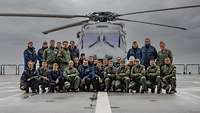
The six members of the WTDWehrtechnische Dienststelle 61 test team with the MFGMarinefluggeschwader 5 pilots and crew members of Combat Support Ship “Bonn”
Bundeswehr/Dominique SchneiderEarly March 2023 on the North Sea: The combat support ship (CSS) “Bonn” is plowing through the waves. Full operational readiness of a CSS requires a helicopter ready for operation and the expertise to judge whether weather conditions still allow for takeoffs and landings on the high seas.
The plan was to provide the limits, the so-called Ship/Helicopter Operating Limitations (SHOLsShip Helicopter Operating Limitations), for the Sea Lion as quickly as possible. SHOLsShip Helicopter Operating Limitations are limit values that determine the wind speeds and directions which still allow a helicopter to safely take off and land on a vessel,” explains the technical task manager of WTDWehrtechnische Dienststelle 61. Another factor incorporated into the SHOLsShip Helicopter Operating Limitations is the subjective rating scale, i.e. the work stress of pilots: “That is the level up to which a pilot with standard training can still successfully complete a landing,” one of the test pilots explains.
In the test procedure used so far, the acceptable safe limit of the helicopter, the pilots or other factors such as the work stress of the crew had to be approached carefully and in small increments. As the wind conditions kept changing, the tests would be repeated until the respective limit was reached. “The limiting factors in this case are the engine power available, the specific control limits, and also the test pilot’s feeling for how the behavior of the helicopter affects controllability,” the technical task manager said. This method required a large number of takeoffs and landings.
For this reason, WTDWehrtechnische Dienststelle 61 was tasked with determining the SHOLsShip Helicopter Operating Limitations as early as 2020, even before the first Sea Lion was officially handed over to the Navy.
The test team quickly agreed to draw on the experience of the Netherlands Aerospace Center. In cooperation with the Dutch Navy, a time-saving method for determining the SHOLsShip Helicopter Operating Limitations was developed there: it is based on a combination of data from wind tunnel tests and flight tests on land, validated by field tests at sea.
The consultations with all parties involved required a lot of organizational skills and some lead time. “One of the most critical points was to get one of the rare time slots on a combat support ship to conduct the tests,” a test flight engineer of WTDWehrtechnische Dienststelle 61 recalls. “Initially, the plan was to use the CSS ‘Frankfurt am Main#de’ – in September 2022. That did not work out, however, and everything had to be rescheduled,” adds his colleague, another WTDWehrtechnische Dienststelle 61 test flight engineer. Finally, the team was assigned two weeks on the CSS “Bonn” in early 2023.
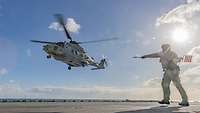
Full attention is required – not only in the air
Bundeswehr/Dominique SchneiderIn advance, MFGMarinefluggeschwader 5 conducted a four-week operational suitability test concerning the operational maturity of the system: one week in the safety of the harbor, followed by a week on the deck of the combat support ship and another two weeks in flight operations. The two WTDWehrtechnische Dienststelle 61 test pilots supported the Navy for one and a half weeks to build up joint experience.
A container full of equipment was brought from the WTDWehrtechnische Dienststelle 61 premises in Manching in Bavaria to the coast of the North Sea to simulate a real operational scenario for flight testing. “The weight of the helicopter during the test flights has to match the full operational weight,” explains one of the test pilots. This weight of ten to eleven tons was achieved using, among other things, crash test dummies and 1.2 tons of lead.
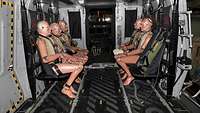
Safety first: even dummies are strapped in
Bundeswehr/Dominique SchneiderSleeping aboard a ship – that is not an everyday occurrence for the WTDWehrtechnische Dienststelle team. For the duration of the test, they were part of the crew of the CSS “Bonn”.
The daily crew briefing was followed by briefings for the helicopter crew and the test flights. “The most important question for us in the morning was always whether the weather would provide us with the wind we needed for our tests,” one of the test pilots remembers. Luckily, the wind blew in all the required strengths on the five available test days. “Depending on which wind was predicted and where, we had to move to the respective sea area.”
All test flights were conducted in close cooperation in teams of four, each including a pilot and a test flight engineer of the WTDWehrtechnische Dienststelle as well as a pilot and a flight mechanic of the Navy.
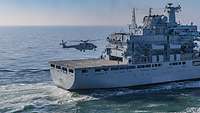
NH90 is landing on the combat support ship
Bundeswehr/Jan KleuBut what makes landing in windy weather so difficult, even dangerous? The pilots explain: “The flight deck is located at the rear of the CSS – behind the large upper works of the ship. The wind flows around them and creates swirls of air in their wake – right where the helicopter has to approach and land.” It is, of course, possible to alter the ship’s course to make the wind conditions easier by changing the landing direction. “However, this is not always possible for a number of reasons. In peacetime operations and with a lot of time at your hands, you could certainly at least try,” say the experienced pilots. “But we have to assume that we are working in operational scenarios. In such conditions, it may not be possible to maneuver for a variety of reasons: maybe you are moving in company, or maneuvering would endanger the operation.”
As the NH90 approaches the CSS “Bonn”, the high winds are clearly visible
“Based on the data of the Netherlands Aerospace Center, we knew where we had to start – at which point things might turn critical. And that is what challenges us, what we are trained for,” said one of the two test pilots.
Three approach procedures, each of which was approached both from starboard and port, were relevant: approaching parallel to the ship, drawing abreast the landing pad, then moving in to land at a 90° angle to the ship, with the helicopter’s nose ahead. Approaching and landing at an angle coming from the rear. Or approaching at a 90° angle to the ship from the very beginning. “All in all, we spent about 30 hours in the air for testing, eight and a half of them at night. Night landings are the greatest challenge,” the crew agrees. “It’s black outside. Pitch black. We are wearing our night vision goggles and have to use the intensified low light to orient ourselves,” one test pilot says. “Quite strenuous, but that is part of the deal. We did a total of 73 night-time landings in the end.”
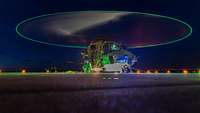
Highest concentration is the priority during the challenging night flights
Bundeswehr/Dominique SchneiderAfter each takeoff and each landing, procedures, measurement data and landing conditions were rigorously documented.
During the campaign, more than 300 landings on the flight deck allowed the crew to cover all necessary SHOLsShip Helicopter Operating Limitations and to document the limits within which naval aviators can perform for safe on-board operations. The accumulated results will be incorporated into regulations for NH90 flight operations and will also serve as a basis for subsequent training on the NH90. Another result of testing was that the test pilots and naval aviators made additions to the orientation marks on the flight deck of the CSS..
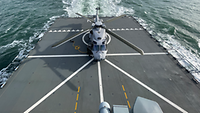
The orientation markings on the flight deck of the combat support ship
Bundeswehr/Josef Rauschecker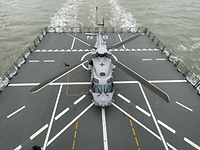
In future, each CSS is to be marked with additional orientation markings
Bundeswehr/Josef Rauschecker